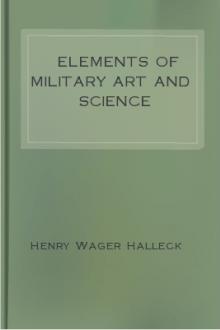Elements of Military Art and Science by Henry Wager Halleck (books you have to read txt) 📕

- Author: Henry Wager Halleck
- Performer: -
Book online «Elements of Military Art and Science by Henry Wager Halleck (books you have to read txt) 📕». Author Henry Wager Halleck
Artillery placed on a plain, or with ground slightly inclined in front, and using the point-blank or ricochet fire, is the most effective; very high points are unfavorable If possible, the concentric fire should be employed against the enemy's columns of attack. The position of the English artillery on the field of Waterloo, and the use of the concentric fire, furnishes one of the best examples for the disposition of this arm to be found in modern military history.
The proper use of artillery on the battle-field is against the enemy's infantry and cavalry, consequently only a small part of it should be employed to respond to the fire of the enemy's batteries; not more than one third at most can be spared for this object.
If possible, batteries should be established so as to take the enemy's line in flank, either by an oblique or enfilading fire. A direct fire against columns of attack, with a few light pieces thrown out to take it in flank at the same time, will always be advantageous. A direct and flank fire was employed with success by Kleist against the column of Ney at the battle of Bautzen; the French marshal was forced to change his direction.
Batteries should always be well secured on the flanks, and constantly sustained by infantry or cavalry. If attacked by cavalry, the artillery should keep up its fire as long as possible, first with ball, and then with grape when the enemy arrives within a suitable distance. The same rule will apply to attacks of infantry, except that the fire of solid shot at a great distance is much less effective than against mounted troops.
The engineer troops are employed on the field of battle principally by detachments, acting as auxiliaries to the other arms. Each regiment of infantry should have a detachment of sappers armed with axes to act as pioneers, for the removal of obstacles that may impede its advance. These sappers are of the utmost importance, for without them an entire column might be checked and thrown into confusion by impediments which a few sappers with their axes would remove in a very short time. Detachments of engineer troops must also act in concert with the cavalry and artillery for the same purpose as above. In establishing the batteries of artillery, in opening roads for their manœuvres, and in arranging material obstacles for their defence, the axes, picks, and shovels of the sappers are of infinite value. Field-works, bridges, and bridge-defences, frequently have a decisive influence upon the result of a battle, but as these are usually arranged previous to the action, they will be discussed in another place. In the attack and defence of these field-works, the engineer troops play a distinguished part. The consideration of this part of the subject, though perhaps properly belonging to the tactics of battles, will also be postponed to another occasion.
We will now discuss the employment of the combined arms on the field of battle.
Before the French Revolution, all the infantry, formed by regiments and brigades, was united in a single body and drawn up in two lines. The cavalry was placed on the two flanks, and the artillery distributed along the entire line. In moving by wings, they formed four columns, two of cavalry and two of infantry: in moving by a flank, they formed only two very long columns; the cavalry, however, sometimes formed a third and separate column in flank movements, but this disposition was rarely made.
The French Revolution introduced the system of grand divisions composed of the four arms combined; each division moved separately and independently of the other. In the wars of the Empire, Napoleon united two or more of these divisions into a corps d'armée, which formed a wing, the centre, or reserve of his grand army. In addition to these divisions and corps d'armée, he had large reserves of cavalry and artillery, which were employed as distinct and separate arms.
If the forces be sufficiently numerous to fight by corps d'armée, each corps should have its own reserve, independent of the general reserve of the army. Again, if the forces be so small as to act by grand divisions only, each division should then have its separate reserve.
An army, whether composed of separate corps or of grand divisions, usually forms, on the field of battle, a centre, two wings, and a reserve. Each corps or division acts by itself, with its infantry, cavalry, artillery, and engineer troops. The reserve of cavalry may be formed in rear of the centre or one of the wings. In small forces of fifty or sixty thousand men, the cavalry may act with advantage on the wings, in the manner of the ancients. If the reserve of this arm be large enough to form three separate bodies, it may itself very properly be formed into a centre and wings. If it be formed into two columns only, they may be placed in rear of the openings between the centre and the wings of the main force. The reserve of artillery is employed either to reinforce the centre or a wing, and in the defensive is frequently distributed throughout the whole line of battle. In offensive operations, it may be well to concentrate as much fire as possible on the intended point of attack. The mounted artillery either acts in concert with the cavalry, of is used to reinforce that arm; the light-foot acts with the infantry, and the batteries of heavy calibre are distributed along the line, or concentrated on some important point where their fire may be most effectual. They reach the enemy's forces at a distance, and arrest the impulsion of his attack. They may also be employed to draw the fire of his artillery; but their movements are too slow and difficult for a reserve.
The order of succession in which the different arms are engaged in a battle, depends upon the nature of the ground and other accidental circumstances, and cannot be determined by any fixed rules. The following, however, is most frequently employed, and in ordinary cases may be deemed good.
The attack is first opened by a cannonade; light troops are sent forward to annoy the enemy, and, if possible, to pick off his artillerists. The main body then advances in two lines: the first displays itself in line as it arrives nearly within the range of grape-shot; the second line remains in columns of attack formed of battalions by division, at a distance from the first sufficient to be beyond the reach of the enemy's musketry, but near enough to support the first line, or to cover it, if driven back. The artillery, in the mean time, concentrates its fire on some weak point to open a way for the reserve, which rushes into the opening and takes the enemy in flank and rear. The cavalry charges at the opportune moment on the flank of the enemy's columns or penetrates an opening in his line, and cutting to pieces his staggered troops, forces them into retreat, and completes the victory. During this time the whole line of the enemy should be kept occupied, so as to prevent fresh troops from being concentrated on the threatened point.
The following maxims on battles may be studied with advantage:—1st. General battles are not to be fought but under the occurrence of one of the following circumstances: when you are, from any cause, decidedly superior to the enemy; when he is on the point of receiving reinforcements, which will materially effect your relative strength; when, if not beaten or checked, he will deprive you of supplies or reinforcements, necessary to the continuance or success of your operations; and, generally, when the advantage of winning the battle will be greater than the disadvantage of losing it.
2d. Whatever may be your reason for risking a general battle, you ought to regard as indispensable preliminaries,—a thorough knowledge of the ground on which you are to act; an ample supply of ammunition; the most perfect order in your fire-arms; hospital dépôts regularly established, with surgeons, nurses, dressings, &c., sufficient for the accommodation of the wounded; points of rendezvous established and known to the commanders of corps; and an entire possession of the passes in your own rear.
3d. The battle being fought and won, the victory must be followed up with as much alacrity and vigor, as though nothing had been gained,—a maxim very difficult of observance, (from the momentary disobedience which pervades all troops flushed with conquest,) but with which an able general will never dispense. No one knew better the use of this maxim than Napoleon, and no one was a more strict and habitual observer of it.
4th. The battle being fought and lost, it is your first duty to do away the moral effect of defeat,—the want of that self-respect and self-confidence, which are its immediate followers, and which, so long as they last, are the most powerful auxiliaries of your enemy. It is scarcely necessary to remark that, to effect this object,—to reinspire a beaten army with hope, and to reassure it of victory,—we must not turn our backs on an enemy, without sometimes presenting to him our front also;—we must not confide our safety to mere flight, but adopt such measures as shall convince him that though wounded and overpowered, we are neither disabled nor dismayed; and that we still possess enough both of strength and spirit to punish his faults, should he commit any. Do you operate in a covered or mountainous country?—avail yourself of its ridges and woods; for by doing so you will best evade the pressure of his cavalry. Have you defiles or villages to pass?—seize the heads of these, defend them obstinately, and make a show of fighting another battle. In a word, let no error of your enemy, nor any favorable incident of the ground, escape your notice or your use. It is by these means that your enemy is checked, and your troops inspirited; and it was by these that Frederick balanced his surprise at Hohenkirchen, and the defeat of his plans before Olmutz. The movement of our own Washington, after losing the battle of Brandywine, was of this character. He hastily recrossed the Schuylkill with the professed intention of seeking the enemy and renewing the combat, which was apparently prevented only by a heavy and incessant fall of rain. A rumor was now raised that the enemy, while refusing his left wing, was rapidly advancing upon his right, to intercept our passage of the river, and thus gain possession of Philadelphia. This report justified a retreat, which drew from the General repeated assurances, that in quitting his present position and giving to his march a retrograde direction, it was not his object to avoid, but to follow and to fight the enemy. This movement, though no battle ensued, had the effect of restoring the confidence as well of the people as of the army.[11]
[11]
There are innumerable works in almost every language on elementary tactics; very few persons, however, care to read any thing further than the manuals used in our own service. Our system of infantry, cavalry, and artillery tactics is generally taken from the French; and also the course of engineer instruction, so far as matured, for sappers, miners, and pontoniers, is based on the French manuals for the varied duties of this arm.
On Grand Tactics, or Tactics of Battles, the military and historical writings of General Jomini abound in most valuable instructions. Napoleon's memoirs, and the writings of Rocquancourt, Hoyer, Decker, Okouneff, Roguiat, Jocquinot-de-Presle, Guibert, Duhesme, Gassendi, Warnery, Baron Bohan, Lindneau, Maiseroy, Miller, and Ternay, are considered as being among the best authorities.
CHAPTER VI.MILITARY POLITY AND THE MEANS OF NATIONAL DEFENCE.
Military Polity.—In deciding upon a resort to arms, statesmen are guided by certain





Comments (0)